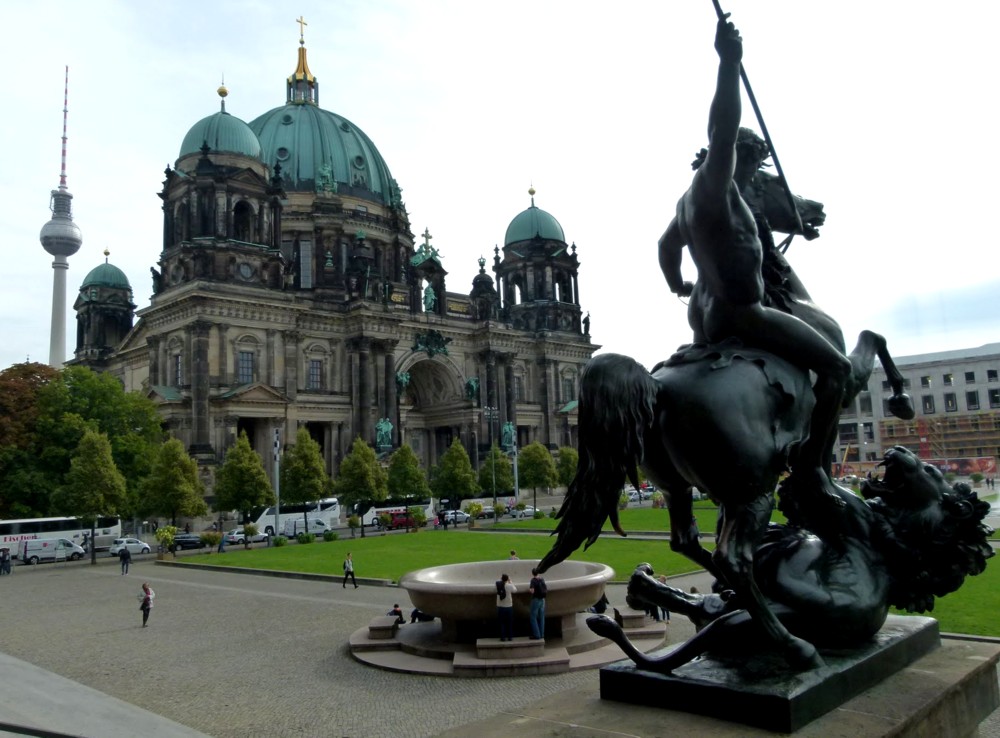I'm a bit daunted writing about Berlin.
Somehow I'm happy to put down a couple of paragraphs about many other cities and towns I've visited but there are some that seem too complicated for a quick 'off the cuff' summary. Sydney of course, my present home town, and past home towns like New York and London. I know just too much about them for a glib first impression.
Although I've never lived there I've visited Berlin on several occasions for periods of up to a couple of weeks. I also have family there and have been introduced to their circle of friends.
So I decided that I can't really sum Berlin up, any more that I can sum up London or New York, so instead I should pick some aspects of uniqueness to highlight.
The most obvious difference when one gets off the plane is that people in Berlin speak, read and write in German.
Despite being told that tourists can easily make themselves understood in Germany because almost everyone speaks some English, the reverse is not true.
Try sitting in a café over brunch with a group of German friends who are not about to attempt to communicate amongst themselves in poor English just so you can follow. You will find yourself sitting there smiling like an idiot as they laugh and chatter, until you know enough German to catch the drift of the conversation or someone takes pity and fills you in.
For English speakers, normal domestic life, like shopping in the supermarket, can also be tricky. Some groceries are obvious, like different varieties of cheese, but can you distinguish full cream, light or skim milk from sour milk or yoghurt; or hair conditioner from shampoo? Even using the S-Bahn or U-Bahn can be tricky. It's simple until a train is cancelled or a line closed and there are alternate route instructions in German only.
Catching an alternative train - I've decided that these are properly named: Ironic Columns
It's the same pun in German so I'm not at all sure the ionic caps aren't a deliberate joke
What would you expect? Of course you need to learn some German it you want to go there for any length of time and would like to move outside the standardised tourist bubble. I've talked about organised package tours elsewhere. They're appropriately named as each tourist becomes a package to be labelled and dispatched here and there; contained by bus and hotel or moving as a self-protective organic group.
Then there are 'The Things to See'. Every city in the world has a unique list of places and things to see that the tour companies have identified, prioritised and put on their itineraries: "You went to Sydney and didn't climb the Bridge? Oh, you missed the best bit!"
In Berlin it's the Brandenburg Gate; Checkpoint Charlie; remnants of The Wall; the memorial to murdered Jews; the Fernsehturm (television tower); the Reichstag (parliament building) Dome; the Berliner Dom (the cathedral); and the nearby museums.
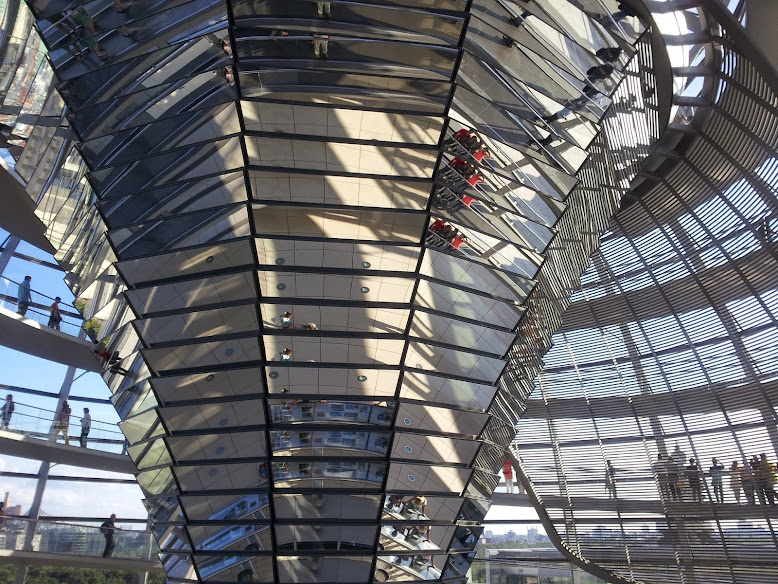 |
|
Brandenburg Gate; Checkpoint Charlie; Reichstag and its dome; Berliner Dom; Fernsehturm
But like the iconic places in other cities, Berliners go about their business hardly giving these tourist 'must sees' a second look, disturbed only by annoying tour groups blocking pedestrian traffic.
Museums
Berlin is Museum City. The tourist site visitberlin.com publishes a list of over one hundred museums within the city. Several are world famous like those on Museum Island: the Pergamon Museum; Bode Museum; Altes Museum; Neues Museum (with the bust of Nefertiti); and the Alte Nationalgalerie, where visiting art exhibitions take place.
 |
Gemäldegalerie; Kunstgewerbemuseum; Deutsches Technikmuseum; Märkisches Museum; Museum Island (as listed above)
Like cities every museum has objects that are one of a kind. So every museum is also unique. But uniqueness is not, of itself, grounds for a visit. I find it hard to get excited about stamps or coins, particularly when there are hundreds or thousands of them. So the Numismatic Museum in Athens that specialises in coins was low on my priority list. Similarly I find it hard to get excited about some cities.
But I'm interested in painting and sculpture because I like to dabble myself so I'll usually find something to catch my interest in an art gallery. The art museum that has surprised me the most is the Gemäldegalerie near Potsdamer Platz. It's not on the normal Tourist Schedule. If you are familiar with the European art collections at the National Gallery in London or the Orsay in Paris or the Uffizi in Florence or the Prado Madrid or the Rijksmuseum in Amsterdam you'll still be very impressed.
The Alte Nationalgalerie on Museum Island is good and it's on the tourist itinerary but it's put into the shade by the Gemäldegalerie collection. This includes a dozen or so Rembrandts, and several works each by Hals, Vermeer, Titian, Rubens, Boucher, Holbein, Brueghel, Durer, Cranach, Botticelli and even English masters like Gainsborough. Amazing!
Rubens (being copied); Holbein; Cranach; Boucher; Vermeer; Rembrandt; Tiepolo; Canaletto; Caravaggio; Velázquez;
the list goes on.
And there was no queue to get in.
I'm also interested in technology, history and natural history: biology and geology. So in Berlin almost every museum is interesting and it's possible to spend weeks visiting and revisiting them - and that's before you even begin to scratch the contemporary arts scene.
Perhaps this is best illustrated by the amount of street art and graffiti. Graffiti is everywhere. It is said that for many years there was a lack of paint in East Berlin and so buildings were drab and grey - an ideal canvas for street artists who could lay their hand on some paint. Today there are still many disused buildings where artists gather to play music and paint and there are some very public areas where street art is actively encouraged.
 |
|
Berlin Street Art
Living in Berlin
Berlin is not huge. It's smaller in population than Sydney. But then that always depends on where you draw the boundary. Berlin has large stretches of green space and achieves its urban density through a predominance of multistorey apartment living. As a result the urban population density of Berlin is over ten times greater than Sydney (Sydney: 372 persons per square kilometre; Berlin: 3,944). But this is not particularly dense. Paris, that is officially half the size of Berlin or Sydney is over five times denser than Berlin.
Thus Berlin is somewhere in the middle contributed to by Germany having one of the largest dwelling areas per person in Europe (reference). For example the average Berlin apartment is substantially more commodious than an average London home. Nevertheless, this density is sufficiently high to support excellent and inexpensive urban transport so that in general people prefer it or cycling to driving and leave their cars at home. So road traffic flows relatively well compared to many cities. Bikes are popular because Berlin is quite flat. There are extensive bike lanes often sharing the pavements with pedestrians. This can be a walking hazard but as almost everyone has a bike it's a communally accepted risk. Helmets are not de jure and are seldom worn by adults, solving the Australian problem of what to do with them when you leave your bike and don't want the inconvenience of carrying a bike helmet (or want to appear to be a bike-nerd / health-freak) and 'Cycling Lycra' is certainly not the de jour clothing choice of the average Berlin cyclist.
A great deal of older Berlin housing consists of five storey apartment blocks, sometimes with an attic level above. These are built up to a rectangular street alignment leaving a large rectangular green space inside the square at the rear. At intervals there are carriage entrances to this rear area which presumably once provided stabling for horses and carriages. Sometimes cars or bike sheds have made their way into this common space but mostly it is green and in some places playgrounds or café facilities use it, as in the block across from where Emily lives.
 |
Berlin apartments: Street side; rear window; Google Earth view of city blocks;
Restaurant in adjacent block - once DDR communal dining room - meals 5 euro (main plus drink)
These older blocks were largely in working class areas but are undergoing a process of gentrification. The apartments are solidly built typically with at least two large rooms and a kitchen/scullery that has usually been converted to include a bathroom. Upgrading usually involves modernising the kitchen and bathroom and perhaps, as in Emily and Guido's case, combining two smaller apartments into one. As far as I can see all Berlin apartments are centrally heated and have modern double glazing. Emily tells me that the law compels landlords to renovate and put in double glazing and heating, as this saves energy and reduces air pollution. Apparently before the old coal ovens were taken out Berlin had a very 'mysterious' atmosphere, clouded in haze during winter.
But there are no lifts and they have very high ceilings that make walking up several stories with groceries or carrying a child or luggage better than a trip to a gym.
East and West
A few hundred metres from Emily and Guido's apartment is Frankfurter Allee that turns into Karl Marx Allee at Frankfurter Tor (left hand side in the Google Earth image above). If you stand in the centre margin of this road and look towards the centre of town the Fernsehturm (television tower) is in the centre of your view.
Karl Marx Allee near Frankfurter Tor - historical photograph: Märkisches Museum
On either side are matching grand buildings - all post-war.
These owe their existence first to the War and then to the Communists. To the south of Frankfurter Allee are two major rail junctions and from here low level British bombers could unload all the way into the centre at Alexanderplatz by flying along Große Frankfurter Straße.
Alexanderplatz 1945 and 2015 (setting up for Oktoberfest)
The S-Bahn on the left in the 1945 photo runs between the darker grey building and the TV tower
This was East Berlin. The historical photographs are in the Märkisches Museum
They needed to keep low and south of Frankfurter Allee to avoid anti-aircraft fire from the Friedrichshain Flak Tower, more of that later.
Whereas high level bombing known as carpet bombing was more indiscriminate low level bombing concentrated damage along this corridor leaving a great swathe of destruction, an ideal site for a grand soviet style reconstruction project: Stalin Allee. And so it happened. Women were put to work clearing the rubble. Plans and models were made and in due course construction began on what had become a component in the propaganda war between East and West.
The grand soviet-style reconstruction project: Stalin Allee - Märkisches Museum
Who could clean-up fastest and best became a points scoring exercise. Soon Stalin Allee rose from the most devastated area in the City. It was like the rebuilding of Warsaw, a great communist achievement.
On the other (south) side of Frankfurter Allee from Emily are a series of high rise apartments of the kind often disparaged in the West when talking of the East. The West decried the architecture while the East heralded new apartments with lifts and modern bathrooms and kitchens.
It sounds odd to Australians, and to all of us now, but in much of Europe a bathroom was a novelty and the height of luxury before the War. When we looked at buying a house in London in the mid 1970's it was still possible to get a special grant to install a bathroom as immediately after the war only the middle and upper classes had such luxuries. One day I was riding my bike to work and passed a group of kids in Battersea and heard one say: "Oh no, its bath night!". 'Oh no! It's true,' I thought. When I was a 'pommy' kid in growing up in Australia a favourite joke of other kids was: "Where do you hide your wallet from and Englishman? Under the soap! Ha Ha." As for hot water in the kitchen - haven't you heard of a kettle?
So these projects were indeed making things better for working class Berliners.
The Russian occupation in what was called the Soviet (sowjetischer) Sector was famously fraught with a power-play between the Germans and Russians. There is a current Spielberg movie Bridge of Spies that highlights the tension when a DDR (Duecher Democratic Republic - East German) official points furiously at the lack of progress on cleaning up the Soviet Sector compared to progress in the British, French and American sectors. The movie is bleak, contrasting the worst of Berlin with an upper-middle-class commuter suburb of New York - no sight of the South Bronx from the commuter train - and the script does not treat the DDR man or his clown-like boss at all well.
In due course Stalin fell from grace. So Stalingrad became Volgograd and Stalin Allee became Karl Marx Allee. But the DDR competition with the West was still in full swing when the Fernsehturm (television tower) was built between 1965 and 1969. It's still the tallest structure in Germany.
Nostalgia
Not everyone remembers the DDR as the horrible administration depicted in the West. Thus when you use a pedestrian crossing in Berlin you still see a little walking man from the Eastern sector, sometimes adjacent to the walking man from the West, as in Potsdamer Platz. Berliners love Ampelmann and he's on many tourist souvenirs.

Berliners love Ampelmann
So former Große Frankfurter Straße is still called Karl Marx Allee and Berliners have resisted calls to restore the old name. There is also a separate Karl-Marx Straße in Berlin and neither is some little back street. Emily's local U-Bahn station is still decorated with communist-era murals depicting stages in the People's struggle.
Magdalenenstraße U-Bahn station
But in town there is a DDR (GDR) Museum that sheds a dim light on the previous East Germany.
Strangely enough quite a few of the infamies on display, like primitive kitchen appliances and waiting lists for cars and phones, also applied in the West in the 1950's. Britain still had rationing then and my Grandmother who died in 1982 never owned a refrigerator.
The impression given of the DDR is of a country caught in a 1950's time warp and some Berliners are nostalgic.
They still rip off their clothes and go natural, when swimming on hot summers days, as they did in the DDR as a kind of social rebellion: resisting conformity; or perhaps an expression of pure classlessness.
Resistance to conformity or classlessness? But it still goes on (photograph in the DDR Museum)
Old cars are a never-ending expression of nostalgia. There is an active Trabant car owners club some of which can still be seen around town, like Morris Minors in Australia and Britain.
Trabants - they go on and on and on (No sorry! - That's the slogan of those pollution free ones)
There was one respect in which the DDR surpassed the West. Their domestic secret service, the Stasi, managed to extend the 1950's intrusions into private lives of the Hoover led FBI to new levels and probably blackmailed politicians too; not to mention mimicking the paranoia of Senator McCarthy and our own ASIO.
There's a Stasimuseum two blocks away from Emily's place that shows how they were protecting the DDR from the dead hand of capitalism.
Exhibits in the STASI Museum:
hidden cameras; Freie Deutsche Jugend (Free German Youth) FDJ, military and social duty;
Western Imperialism; CIA spying, terror, torture and brainwashing
They had to be ever vigilant against crimes against the state, predominantly involving paranoid surveillance of anyone suspected of not being a good citizen. Youth culture was of particular concern.
| A list of 'Subversive attacks on the State' (by young people)... 'in particular political-ideological diversions of hostile institutions, organisations and other forces: - doubt about the correctness of our policies party and government It goes on to list additional crimes: 'modern' haircuts; listening to western music stations; truancy |
The overwhelming impression is of bureaucratic incompetence as to targets and laughable lengths, in the light of present technology, to get a fuzzy illicit photograph of someone. A camera in the radio (in the photograph above) is about the least ridiculous.
But it was their doctrinaire pigheadedness and abuse of power that led to Berliners rebelling and overthrowing the whole incompetent crew. At the end of 1989 communist regimes were in trouble across Europe. In Berlin young people took heart and there was a civil uprising against the Stasi with demonstrators demanding that the Ministry of State Security be disbanded. Then on November 9th the DDR announced that citizens could visit the West
Crowds of young Germans from both sides promptly climbed onto the Berlin Wall and embraced each other. Over Christmas the first breaches in the Wall were made by enthusiastic citizens using hand tools.
Sacking the Stasi Offices
Once the Wall was breached German reunification was only months away, on October 3rd 1990.
The Wall was not removed to the present extent until 1992 and some sections remain as a reminder.
West (or East - I'm not sure) of the Wall
In this the Berlin experience is totally unique. Other cities were bombed close to destruction but no others were then occupied by polarised former allies in quite the same way. No other city has been so symbolic, in the struggle between market economics and institutionalised communism for a world view, as Berlin.
Remnants of War
When walking in the park (Volkspark) in Friedrichshain with Guido's aunt she pointed out the hill that dominates the landscape and told me that it was built from the rubble left by allied bombing. She added that that place was chosen in order to bury a 'flak tower'.
On the flight over I had been reading Joseph Kanon's Leaving Berlin set after the War. Then Emily leant me Ken Follet's Winter of the World - not as well written but well researched and much more voluminous. So this reference to Flak Towers sparked my interest. Why would anyone bury a tower - why not just knock it down? Ken Follet told me that Berliner's loved them. They provided shelter and their guns told them that someone was fighting back against the waves of bombers that were trying to annihilate them.
So I did a bit of research. At the beginning of the Second World War the Third Reich did not believe in defence. Expenditure on defensive infrastructure detracted from the war effort and was often ineffective, so their slogan was: 'The best means of defence is attack'. They wanted to avoid at all costs the defensive stalemates of the First World War. But when against all their assurances Berlin came under attack from British bombers in 1940 they reluctantly and very rapidly constructed huge castle like structures called Flaktürme (Flak Towers).
They were built in pairs. The Gefechtsturm (the battle tower) was the gun tower and the largest. The smaller Leitturm (search tower) coordinated the defence. Berlin had three pairs. There were also three in Vienna, two Hamburg and others in Frankfurt and Stuttgart.
The word 'Turm' in German can mean 'tower' as in English. But it can also refer to a 'castle'. While the Leitturm resembled a substantially built water tower, the Gefechtsturm (G-tower) was a huge square thirteen story building half the size of a city block with outer walls 3.5 m (11 feet) thick ferro-concrete that looked more like a big castle. At each corner was a cylindrical tower containing a helical access stairway and each was topped with 128 mm (5.0 in) anti-aircraft guns firing explosive shells (producing flak). In addition, each tower had numerous rapid-firing 50mm guns for defence against low flying aircraft and attack on the towers themselves.
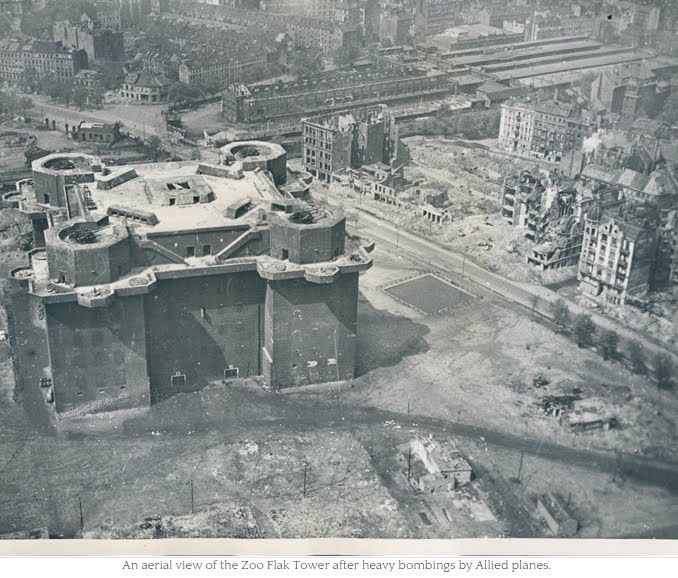
source: http://theelephantgate.weebly.com/the-war-comes-to-the-zoo.html
Allied bombs couldn't penetrate the towers and they acted as local air raid shelters for women and children and men over 70 years old. Men of fighting age were excluded. They also contained an emergency hospital.
So it turned out to be very difficult to remove them, particularly the Gefechtsturm. Towers in Hamburg, Vienna and Stuttgart have been repurposed but in Berlin they had been points of last resistance to the Russian invasion and their popularity with Berliners meant that they had to go. They were located in a triangle around the city. One at the Zoo; one at Friedrichshain and the third at Humboldthain. The only one to be fully demolished was at the Zoo in the British sector.
The French tried blowing up the Gefechtsturm at Humboldthain but success was illusive because of collateral damage to nearby railway tracks. The Russians were similarly unsuccessful at Friedrichshain in the Soviet sector. So the next best solution was to bury the recalcitrant monsters. Thus women, of which there were many more than men, the men being prisoners or dead, were put to work, carrying rubble from the city to cover the remaining towers. Hence Mont Klamott (Rubble Mountain) in Volkspark Friedrichshain.
I want to stay with the Flak towers for just a little longer because when I was looking at photographs of them I saw something that didn't make sense to me. There on the cover of LIFE magazine was a picture of US military women posing with a radar dish that was obviously operating in the microwave band.
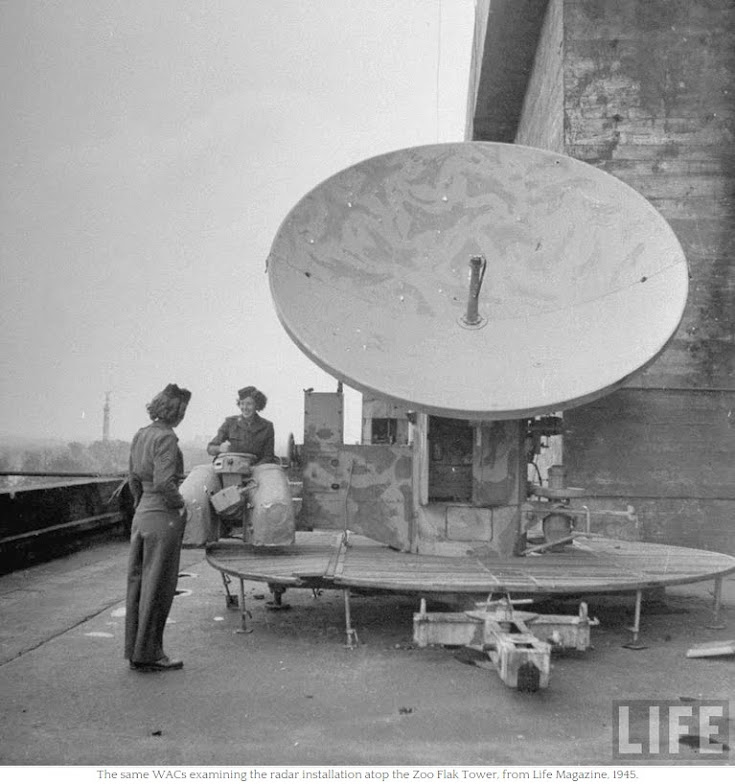
source: http://theelephantgate.weebly.com/the-war-comes-to-the-zoo.html
How could that be? Surely microwave radar was an allied military secret along with proximity fuses? Yet these flak towers clearly had microwave radar controlled guns.
German and British and American technology
(this chapter is for techno-nerds)
We of British heritage all know that the UK has won more Nobel prizes in physics and chemistry per capita than any other country.
But Germany comes in a close second, well ahead of the United States per capita (nevertheless, with four times the population of Germany, the US has many more medals in every category than Britain, Germany and France combined).
The Deutsches Technikmuseum in Berlin vaunts the many world leading German contributions to science, inventions and technological developments beginning with chemistry and progressing through mechanics to biology. One only has to think of Albert Einstein. In the Technikmuseum we can see advances in dyes and explosives as well as internal combustion engines like the contributions of Rudolf Diesel, Karl Benz and Gottlieb Daimler; ramjets; rockets and gas turbines.
Many parallel British advances, like the gas turbine, that one can see in the Science Museum in London.
Although the British inventor Frank Whittle is credited with the first practical gas turbine, a German aircraft the Heinkel He 178 was the first turbojet to fly, based on an engine independently developed by Hans von Ohain. Anselm Franz at Junkers (German) resolved some early design difficulties and the Messerschmitt Me 262 became the world's first operational jet-fighter aircraft, some months ahead of the British Gloster Meteor. Modern aircraft engines incorporate both British and German contributions.
Beuth steam locomotive with a revolutionary steam valving arrangement;
a German gas turbine aircraft engine (above) with a modern type below;
one of 31 German Nobel Prizes in Chemistry - this one for reproductive steroids and the birth control pill;
V1 Rockets (early cruise missiles or drones) - the V2 (not shown) became the basis for the US Space Program
So when my electrical and electronics engineer father had told me that the British invented radar I was inclined to believe him. And it's true to a degree.
The British built a series of radio detection and ranging (RADAR) stations along the coast facing Europe and these were instrumental in detecting attacking German aircraft early enough to 'scramble' fighter pilots, including my father. This enabled them to 'bring down' German bombers in sufficient numbers to make them give up and stop coming. So that's what the acronym 'RADAR' originally referred to, a British invention. But that's not what the word came to mean.
The original British RADAR worked in the normal radio spectrum by triangulation, as do GPS location devices today (in the microwave spectrum), partly by detecting variation in pulses sent out and partly by listening to the aircraft's own radio transmissions.
The German system, invented before the first British system, was based on the way a bat navigates by listening to echoes of ultrasonic beeps it sends out like SONAR. Thus, in development, it was called Elektroakustische Apparate (electroacoustic apparatus). It worked by illuminating a possible target area with rapid pulses of radio radiation the 50 cm band (560 MHz) and timing their reflection. It came to be referred to as: Funkmessgerät (radio measuring device) or FuSE.
Modern radar works the same way, by timing (and analysing frequency changes) in the reflection of a signal previously sent from the same device.
The principle was well known and physicists in several countries were experimenting but to reach the ultra high radio frequencies required for a practical device novel technology was required. A German, H E Hollmann was first to patent a cavity magnetron capable of reaching microwave frequencies in 1935. But it was unstable so the Germans electronics engineers developed the klystron, patented by Irish/American engineers Russell and Sigurd Varian in 1937, to achieve the frequencies needed for their advanced radar systems.
Meanwhile in 1940 at the University of Birmingham John Randall and Harry Boot had never seen a magnetron and had no preconceived ideas but set a goal of finding: 'a microwave source giving one kilowatt on a ten centimetres wavelength'. They quickly settled on a new type of cavity magnetron that made radar practical at much shorter wavelengths and with higher power than the German device.

The anode block - key to the cavity magnetron developed by John Randall and Harry Boot in 1940 at the University of Birmingham.
Microwaves are a surface effect so each hole is in effect a separate one loop coil or resonator
A central cathode is suspended down the axis and powerful magnets cause emitted electrons to
spiral on their way to the anode causing the cavities to resonate - like blowing across a bottle
(obviously the cavity needs to be evacuated - like any radio tube)
Science Museum London / Science and Society Picture Library - Original cavity magnetron, 1940
Shorter was better. It allowed smaller dishes (antenna) and detection of much smaller objects. Their secret was subsequently shared with the US and development work continued at MIT. The secret was also shared with the Varian brothers who set up to develop advanced radar and microwave communications systems in a schoolhouse on the campus of Stanford University in California. This was the genesis of the Stanford Technology Park and the seed that grew into Silicone Valley. A different story. Interestingly, Russian physicists, N F Alekseev and D D Maliarov, had also designed an improved magnetron but Stalin, like Hitler, was a science illiterate (both had won divinity prizes at school) and unbelievably the leading Russian radio scientists were purged. The Institute of Electrical and Electronics Engineers (IEEE) publishes a paper: The Cavity Magnetron: Not Just a British Invention in its Historical Corner for those who would like to know more.
 |
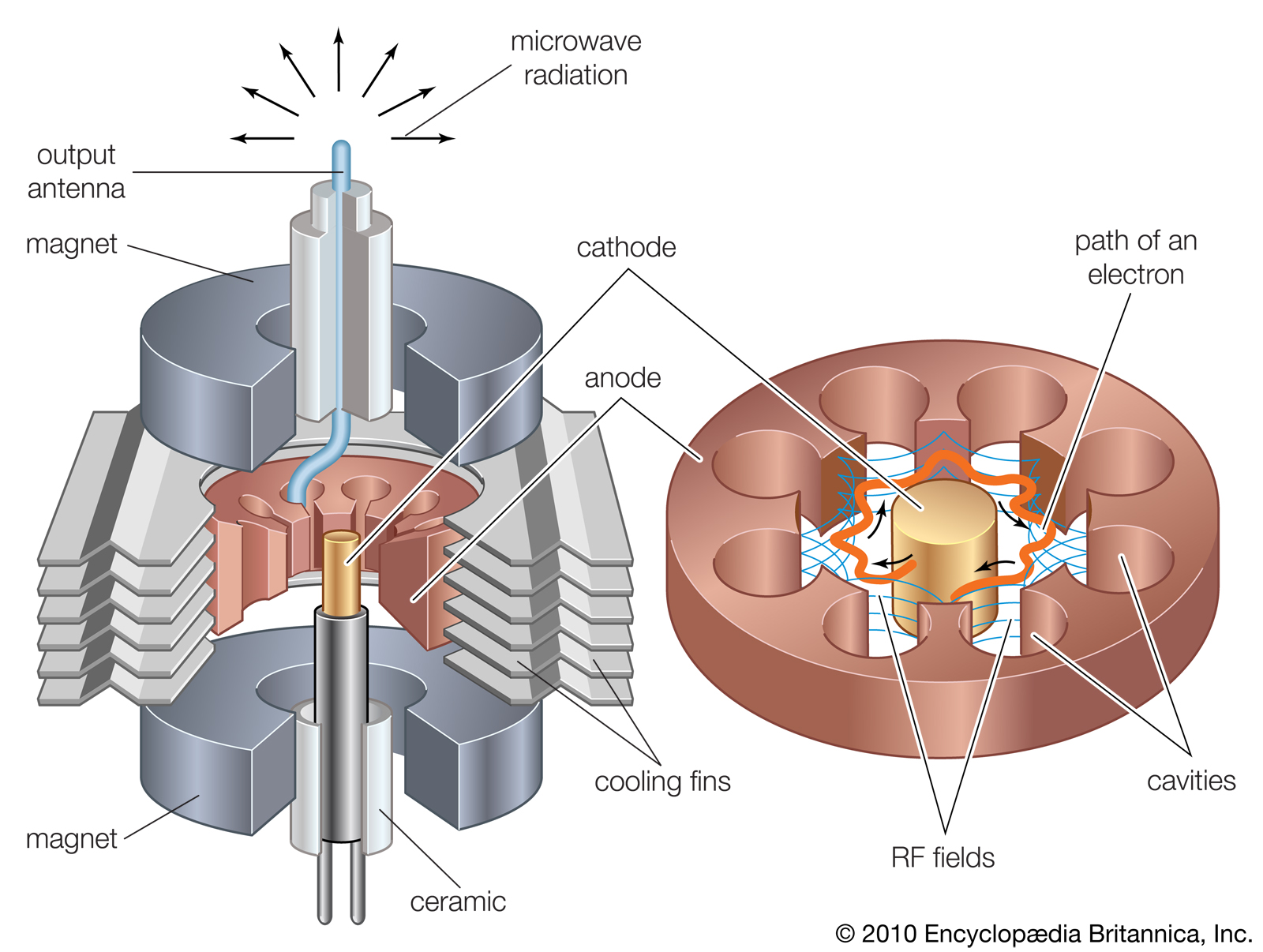 |
The original schematic of the GEC magnetron Type 1189 and microwave oven magnetron
IEEE Antennas and Propagation Magazine, Vol. 55, No. 5, October 2013 and Encyclopaedia Britannica
Today high power cavity magnetrons are produced in the millions and their mode of operation is no longer a secret. These typically produce from 750W to 1200W, much lower power than military radar. But these magnetrons are not for radar but for microwave ovens. In ovens the microwave frequency chosen is a resonant frequency with water molecules that thus readily absorb the radiation and heat your food. This is not a great wavelength for radar as there's lots of energy absorbing water in the atmosphere.
There's an urban myth that the cooking effect was discovered accidently when soldiers or ground crew stood in a 10 or 20 kW radar beam. There's no warning because we have few nerves capable of sensing internal burns so microwave radiation is painless. But the victims were blinded when their eyes were cooked from inside or if exposed for longer, made idiots when their brains were cooked.
This was the original 1950's 'death ray' and it's the source of concern about the excessive use of mobile phones close to ones head. Some have suggested that microwaves would be a good way to beam down energy from large solar energy collectors in orbit. Evil baddies eat your heart out.
Nevertheless provided your microwave oven door is undamaged it's quite safe when you heat your dinner. Obviously there's no residual radiation (except heat) left by radio frequencies that have wavelengths a lot longer than visible light (or shining a light on it would make food radioactive). But NEVER power-up a microwave oven with a broken door.
As you eat your nicely cooked vegetables you can thank those weapons engineers on both sides for just one of many useful 'spinoffs' from their inventiveness.
The history of radar had another twist. Microwaves turned out to be a great improvement on conventional radio for telephone communications and that's why you see those microwave dishes on towers all over the countryside. And it's thanks to the Varian brothers and a German/Swiss named Schottky, that we have the semiconductor devices developed in Silicone Valley, at Fairchild and other places, that most low power radar systems, that open our doors and tell us if we are speeding, now employ. But similar components now provide us with the UHF and microwave communications that enable your mobile phone, WiFi and Bluetooth devices to exist.
Anyway, the gist is that my father was mistaken. The Germans had modern radar before the British. But unlike the British and Americans they failed to perceive its value as a weapon of attack. It was not considered worthy of development expenditure beyond defensive applications, like gun aiming on Flak Towers, where two systems (Kulmbach and Marbach) worked in tandem at 10 cm wavelengths. Eventually captured allied magnetrons revealed their secret, allowing the wavelengths to be shortened further, but it was too late to put these into production.
Nevertheless even the German 10cm radar was very impressive. It allowed the big guns to bring down high-flying bombers at the limit of their range. Using radar and tracking computers the guns were successfully aimed up to two miles ahead of the attacking bombers and the shells were set to explode at their exact height. Planes that frequently changed height avoided the Flak but bomb aimers probably missed their targets as a result.
Collectively the Berlin defences, guns and aircraft, brought down 492 British bombers and damaged a further 954. 'Bomber' Harris, the British Air Marshal, then diverted his attention to easier targets. Later the US Eighth Air Force lost 143 bombers and 29 fighters in just three raids.
Destruction
Despite the Flak towers, and the residual Luftwaffe, Berlin was blasted. British bombers dropped 45,517 tons of bombs then the Americans dropped a further 23,000 tons.
The head of British Bomber Command, Air Vice Marshall 'Bomber' Harris was convinced, despite evidence to the contrary in London, that the morale of civilians was destroyed when their city was attacked and as a result they would put pressure on their government to capitulate.
While Churchill may have had doubts he supported Harris saying: “We need to make the enemy burn and bleed in every way.” In addition he knew that it was good for British morale to bomb German cities in retaliation for London, in what became known as 'feel good raids'. See the above link to 'Bomber' Harris.
Eventually it was realised that the strategy of bombing civilians, if done to excess, hardens their resolve to fight back. We have a modern example in the Gaza Strip. But this was not before raids on Germany killed over 600,000 German civilians and seriously damaged 6 million homes and a halt was finally called to the slaughter. Then came Hiroshima and Nagasaki.
The final wave of destruction in Berlin came ahead of the invading Russian army when, during street to street fighting, the Russians used artillery and tanks to destroy entire buildings that harboured a Hitler Youth offering token resistance.
Berlin in 1945 - Mainly in the British Sector - Märkisches Museum
One obvious moral of the story is that, contrary to Hitler's contention, attack is not the best means of defence. Sitting around a table is. In particular, don't attack someone who might have the means to fight back; or big friends.
It's arguable that this bombing constituted a war crime. But putting that aside, by concentrating bombing on civilian targets a large number of economically strategic targets like transport and electricity infrastructure remained either undamaged or in a state that could be quickly repaired. Those of you familiar with Joseph Heller's Catch 22 will recognise a theme.
For example, about 50 km north-east of Berlin is the strategic Schiffshebewerk (ship lift) on the Oder-Havel canal system. This canal was and is used to move heavy machinery and materials between Germany and Poland, at that time for the assault on the Baltic States and then on the Soviet Union.
Compared with the thousands of tons of bombs committed to killing civilians in nearby Berlin, the bombing raids were token and obviously inadequate to destroy it, because unlike many hospitals and schools in Berlin there it still stands, unscathed.
Schiffshebewerk Niederfinow lowering a barge-load of heavy parts - an obvious strategic target but largely unharmed.
It was built contemporaneously with the Sydney Harbour Bridge and the Empire State building
and uses the same technology - hot riveted, rolled steel trusses.
Steel rolling technology owes its development to rail rolling near Newcastle-on-Tyne see the McKie Family.
The new one being built nearby uses the technology of the late 20th century - ferroconcrete.
If you think failing to disrupt strategic transport to Poland was of little moment consider that between 1940 and the defeat of the Third Reich in 1945 the Nazis would attempt to solve 'the Jewish problem' (whatever that was) and put to death over a million Jews in the gas chambers of Auschwitz in Poland.
To the north of Berlin, not far from the Schiffshebewerk, is the Sachsenhausen concentration camp that is almost as chilling as Auschwitz, particularly as it was subsequently used by the Russians as NKVD special camp Nr. 7. So the abuses here carried on during post-war Stalinist purges.
Sachsenhausen Concentration Camp
There is a longer discussion of concentration camps on this website - follow this link
WARNING this content is distressing.
As I've said repeatedly on this website none of us born after 1940 would have been conceived had any of these players done anything different. Obviously that extends to our children and grandchildren and to those yet to be born. What's done is done and it had to be so for the now to be now. But we should take heed and learn from the horrors as well as the achievements of the past.
In particular, it would be nice if we could put religious and political zealotry behind us. Follow this link to The Meaning of Life - my message to my children and now grandchildren on the subject of religious fundamentalism.
Recovery
It's seventy years on and Berlin has survived all these disasters to emerge from its chrysalis, shedding its tattered shell if still a little ragged around the edges, to take its place as one of the World's great cities and certainly one of the nicest to live in, blending the caring-sharing East with the striving-individualistic West. Young families abound as do playgrounds that are a lot more adventurous and risky and demanding of self reliance than those in litigious Australia.
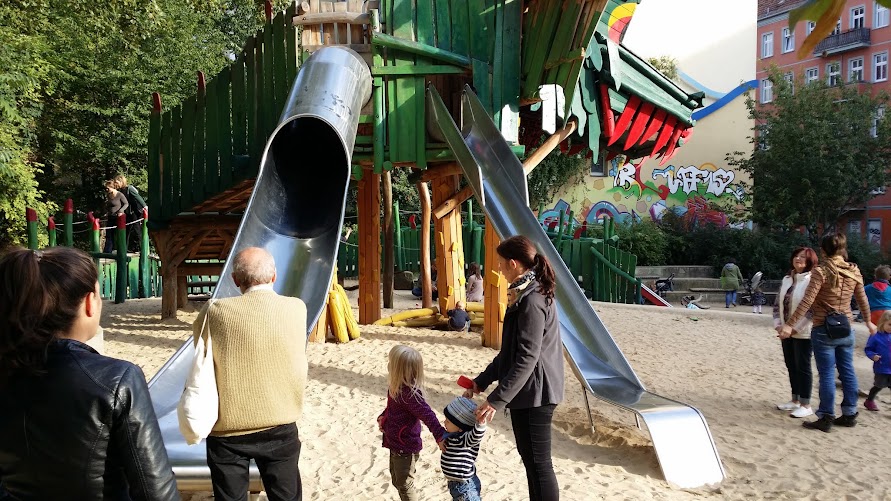
Dragon Park - One of many playgrounds in Berlin - there's a pirate ship too
The small child crouching underneath is my grandchild - playing with bucket and spade
There is an energy to Berlin that is palpable.
Photos of Berlin (including some more)
